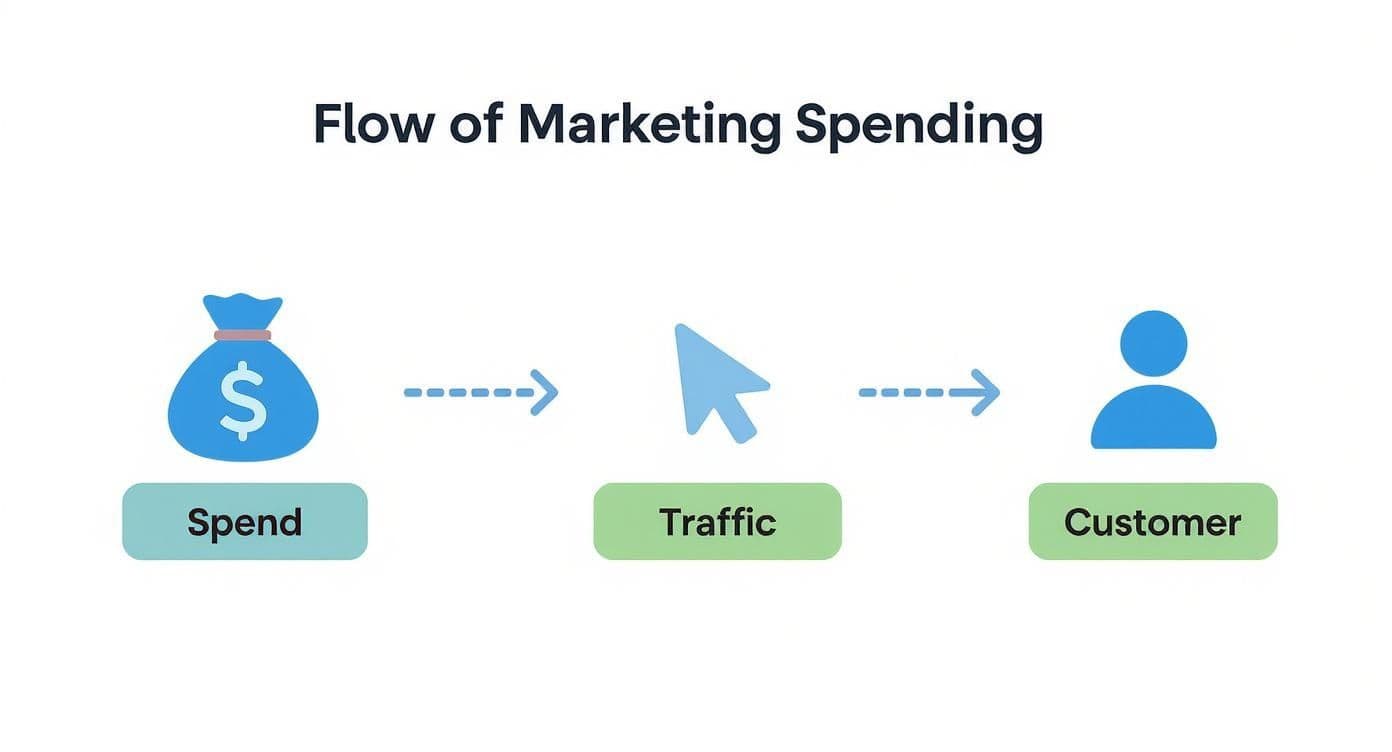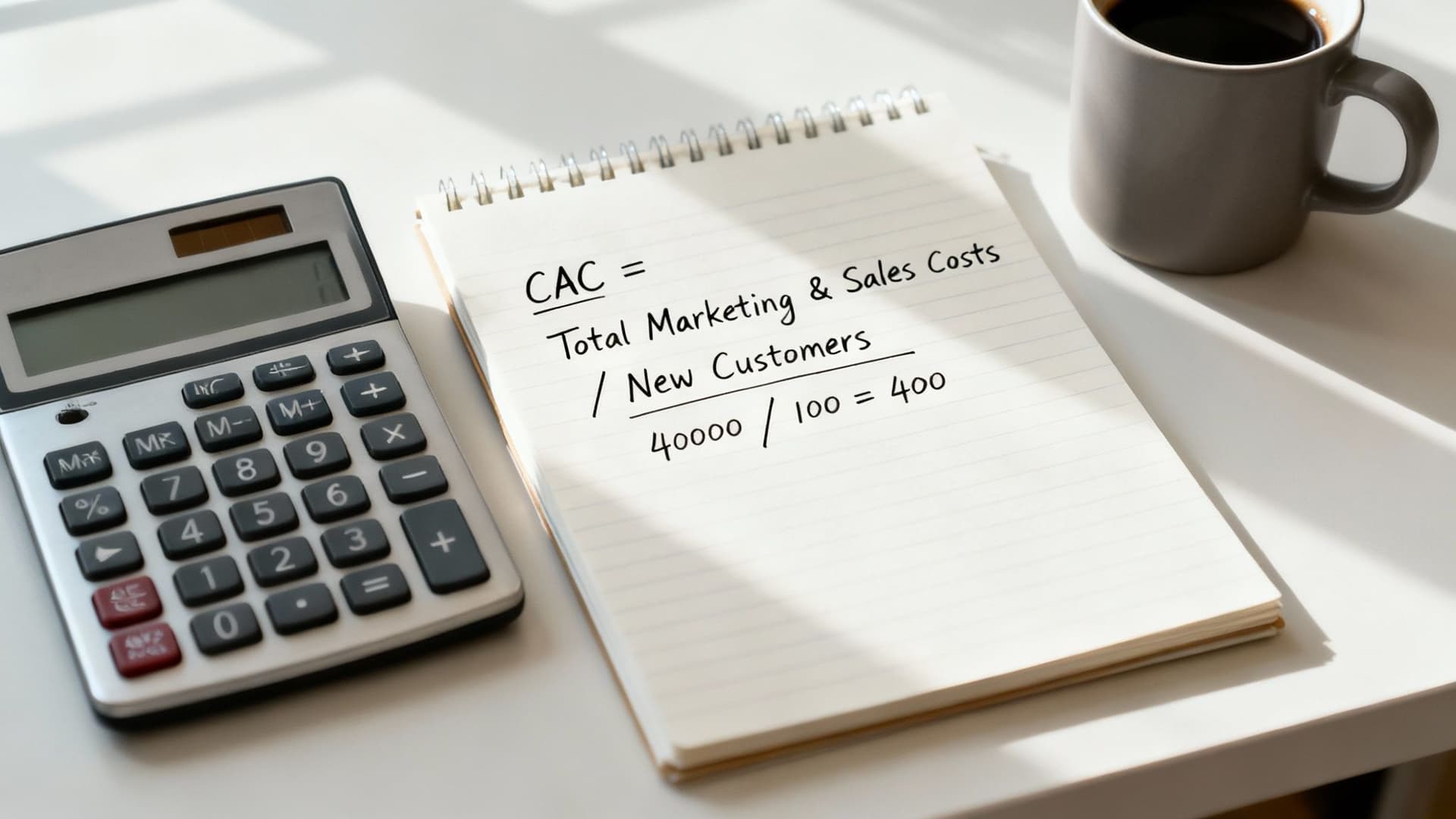If you’re spending on marketing without tracking results, you’re gambling with growth. A CAC calculator turns guesswork into a data-driven plan, showing in clear dollars how much it costs to win each paying customer and where to improve.
October 23, 2025 (2mo ago) — last updated October 30, 2025 (1mo ago)
Customer Acquisition Cost Calculator Guide
Calculate, interpret, and lower your customer acquisition cost to improve marketing ROI and scale sustainably.
← Back to blog
Customer Acquisition Cost Calculator Guide
Summary: Unlock sustainable growth with a customer acquisition cost (CAC) calculator to measure, interpret, and lower acquisition costs for better marketing ROI.
Introduction
If you’re spending on marketing without tracking results, you’re gambling with growth. A customer acquisition cost calculator turns guesswork into a data-driven plan, showing in clear dollars how much it costs to win each paying customer and where to focus improvement efforts.
Why Tracking CAC Is Non-Negotiable for Growth
Advertising costs have risen in recent years, and knowing your Customer Acquisition Cost (CAC) is the difference between smart scaling and wasting budget. CAC isn’t just another metric; it’s the financial pulse of your growth engine.
Imagine a DTC brand running Instagram ads that drive traffic and likes but few buyers. Without CAC, they won’t know if they’re spending $10 to acquire a customer who only spends $25 after product and overhead are accounted for. That thin margin disappears quickly when costs add up.
The Rising Cost of Acquiring Customers
The fight for attention is fiercer than ever, and acquisition expenses have climbed substantially in recent years1.
“High CAC isn’t just a marketing problem; it’s a business model problem. If it costs you more to get a customer than they’re worth over their lifetime, your business is on a countdown to failure.”
From Vague Spending to Clear Profitability
Tracking CAC moves you from assumptions to clarity. While Cost Per Acquisition (CPA) often measures micro-actions like sign-ups, CAC focuses on the end goal: paying customers. That clarity helps you:
- Identify profitable channels—see which channels deliver paying customers, not just vanity metrics.
- Optimize your funnel—pinpoint where prospects drop off and which stages waste budget.
- Set realistic budgets—allocate confidently to the channels that work and cut the ones that don’t.
Once you’ve calculated CAC, compare it to customer lifetime value to judge sustainability. For marketing-focused lifetime estimates, try the Email List Value Estimator.
Gathering the Right Data for Your CAC Calculation
A trustworthy CAC requires accurate inputs. The old saying “garbage in, garbage out” applies. Too many businesses look only at ad spend and miss the full cost of acquisition. An accurate CAC includes every dollar spent to bring in a new customer—campaign budgets and the operational costs that keep marketing and sales running.
Beyond Ad Spend: What to Track
Your ads don’t appear out of thin air. Real people and software drive each click, lead, and sale. If you ignore those expenses, you won’t see the true picture.
Essential Costs to Include in Your CAC Calculation
| Cost Category | Example Expenses | Why It Matters |
|---|---|---|
| Team Salaries | Portions of salaries for marketers, sales reps, and managers focused on acquisition | Team time is a major investment—ignoring it underestimates CAC. |
| Software & Tools | CRM, email platforms, SEO and analytics subscriptions | These recurring costs support acquisition and should be allocated accordingly. |
| Creative & Content | Designer and copywriter fees, video production, stock media | High-quality creative attracts customers and has real costs. |
| Direct Ad Spend | Budget for Google Ads, Meta, LinkedIn, etc. | This is the obvious cost of media buys but only one part of the total. |
| Overhead | Portion of rent, utilities, equipment used by marketing/sales teams | Including overhead gives a more honest view of acquisition costs. |
This holistic tracking turns a vague estimate into a number that reflects business health.

Putting It All Together for an Accurate CAC
The CAC formula is simple but depends on matching precise data. Add up every marketing and sales cost for a period, then divide by the number of new customers in that same period.
Total Marketing & Sales Costs / Number of New Customers Acquired = Customer Acquisition Cost (CAC)
For complex setups, include overhead proportional to marketing team usage—for example, if marketing uses 20% of office space, include 20% of rent and utilities.
Using a clear CAC allows you to set realistic budgets and run internal scenario models. For paid-ad modeling, try the Facebook Ads Cost Estimator to compare channel economics.
The Simple Math Behind the Calculator
A CAC calculator divides total acquisition spending by the number of new customers in the same time frame. The math isn’t mystical, but the data must be precise.

A Quick Example
A B2B SaaS company spent:
- LinkedIn ads: $15,000
- Content marketing: $5,000
- Sales team salaries (new-business portion): $20,000
Total: $40,000. New customers this quarter: 100.
$40,000 / 100 = $400 CAC
This number helps the team decide on pricing, budgets, and growth strategy.
Why Accuracy Is Non-Negotiable
Matching timeframes is essential. Don’t divide Q1 spending by Q2 customers. Your CAC is only as good as the aligned data you input. If the same $40,000 produced 160 customers in another quarter, CAC would be $250—an insight that should trigger a performance review.
If your sales cycle is long, align spending and customer outcomes with the average sales lag rather than rigid monthly buckets. For channel-level decisions, run channel-specific CACs rather than relying solely on a blended average.
Making Sense of Your Customer Acquisition Cost
A standalone CAC is just a number. To give it meaning, compare CAC to customer lifetime value (LTV). The LTV:CAC ratio is the ultimate health check: are you spending to acquire customers who’ll return value over time?
The Magic Ratio for Sustainable Growth
Aim for an LTV:CAC ratio near 3:1—spend $1 to get $3 back over a customer’s lifetime. That indicates enough margin to cover acquisition costs, operations, and to reinvest in growth3.
- A 1:1 ratio indicates a problem—after COGS and overhead, you’re likely losing money on each customer.
- A 3:1 ratio signals efficient, scalable growth.
- A 5:1+ ratio may suggest under-investment in growth—you could be growing faster.
To calculate LTV-related marketing value, consider using the Email List Value Estimator for email-driven lifetime economics.
Actionable Strategies to Lower Your CAC
Calculating CAC is the diagnosis; lowering it is the treatment. A high CAC is a signal to get smarter, not necessarily to spend more. Focus on making every marketing dollar work harder.

Optimize Paid Advertising
Paid channels often make up the largest share of CAC, so they’re the logical place for quick wins. Use your campaign data to double down on high-performing keywords, audiences, and creatives, and cut the underperformers. Modeling tools like the Facebook Ads Cost Estimator can help you project outcomes before you reallocate spend.
Improve Conversion Rates
Driving traffic without converting increases CAC. Improving conversion rate is one of the most powerful ways to lower acquisition cost.
- A/B test landing pages: headlines, CTAs, images, and layouts. Small lifts compound—an extra 1% conversion can change your ROI dramatically.
- Simplify your funnel: reduce form fields and checkout friction to shorten the path to purchase.
- Enhance site speed: slower pages hurt conversions—data shows conversion rates can fall meaningfully as load time increases2.
A better landing experience converts more of the traffic you already pay for, instantly reducing CAC.
Lean Into Organic and Referral Channels
Paid ads deliver speed; organic and referral channels deliver sustainability. Invest in SEO and content marketing to build long-term lead assets. A referral program incentivizes happy customers to bring in new buyers at much lower cost.
When you know your margins, use tools such as the Business Valuation Estimator to set realistic CAC targets and decide how aggressively to invest in each channel.
Common Questions About Calculating CAC
How Often Should I Calculate My CAC?
For most businesses, monthly CAC tracking is the sweet spot: frequent enough to catch trends but not so often you chase noise. Roll monthly numbers up into quarterly and annual views for strategic planning4.
What Is the Difference Between CAC and CPA?
Cost Per Acquisition (CPA) measures the cost of any specific action—newsletter sign-up, trial start, or lead. Customer Acquisition Cost (CAC) is specifically the total cost to acquire a paying customer. CAC is a type of CPA focused on final conversion.
Should I Calculate CAC for Each Marketing Channel?
Yes. A blended CAC is useful for a top-level health check, but channel-specific CACs show where problems or opportunities live. Isolate ad spend channels to see which are truly profitable on their own.
Actionable Q&A (Concise)
Q: What’s the first step to measure CAC?
A: Tally all marketing and sales costs for a defined period and divide by the number of new paying customers in that same period.
Q: What’s a healthy LTV:CAC ratio?
A: Aim for about 3:1—three dollars in customer value for every dollar spent on acquisition3.
Q: Where can I quickly lower CAC?
A: Improve conversion rates, optimize paid campaigns, and invest more in organic and referral channels.
At MicroEstimates, we help businesses build and embed custom calculators to drive leads and improve decision-making. Try the Email List Value Estimator to start modeling customer value.
Ready to Build Your Own Tools for Free?
Join hundreds of businesses already using custom estimation tools to increase profits and win more clients